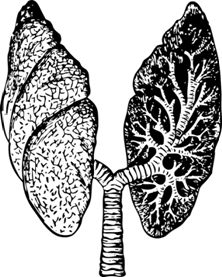Women More Likely To Develop COPD
 A total of 4,484 current and former smokers with COPD from the Genetic Epidemiology of COPD cohort were recently investigated using regression modeling to explore the association between gender, age, disease severity, and the contributing elements of the Global Initiative for Chronic Obstructive Lung Disease (GOLD) classification who were observed across multiple age categories.
A total of 4,484 current and former smokers with COPD from the Genetic Epidemiology of COPD cohort were recently investigated using regression modeling to explore the association between gender, age, disease severity, and the contributing elements of the Global Initiative for Chronic Obstructive Lung Disease (GOLD) classification who were observed across multiple age categories.
Compared to men with COPD, younger women with COPD had a greater likelihood of more severe dyspnea, airflow limitation, greater risk for exacerbations. These differences were less pronounced in older women with COPD. However, older women remained more likely to experience severe dyspnea and to manifest more severe COPD than older men, despite lower pack-years of smoking.
COPD has historically been viewed as a disease of men; however, prevalence and mortality have been increasing in women in recent decades. This has been attributed to increasing rates of smoking among women, and evidence suggests women may be more susceptible to the harmful effects of cigarette smoke and other known COPD risk factors. Gender differences have previously been observed in the clinical manifestations of COPD, with women reporting more severe dyspnea and a higher rate of exacerbations compared to men.
Women and younger patients with COPD tend to report higher levels of physical and psychological symptoms, and women also are over-represented amongst subjects with severe, early-onset COPD. In a study of 2,500 current and former smokers in Genetic Epidemiology of COPD (COPDGene) cohort, females showed an increased the risk of severe early-onset COPD by threefold. The predominance of women with early-onset COPD suggests that younger women may, in general, be more susceptible to severe manifestations of the disease, although more research is needed to clearly define age-by-gender interactions.
Research has begun to explore gender and age differences in the clinical features of COPD; however, no studies have taken a detailed approach to examine gender differences by age across GOLD grades and symptom groups.
The objective of the present study was to explore gender-by-age interactions and disease severity as defined by GOLD groupings and the three key contributing elements of the GOLD classification system (symptoms, exacerbation risk, and airflow limitation severity) using data from a large well-phenotyped COPD cohort.
This study suggests that women are more likely to be significantly burdened by the symptoms of COPD than men, and this effect appears most pronounced among younger women. Although prior results have highlighted important sex and gender differences in men and women with COPD, the modeling of age by gender interactions across the fifth through eighth decades of life is a point of novelty and highlights the clinical imperative to more effectively and thoroughly recognize and manage respiratory symptoms in women.

